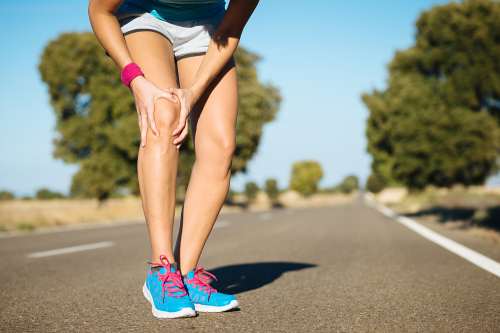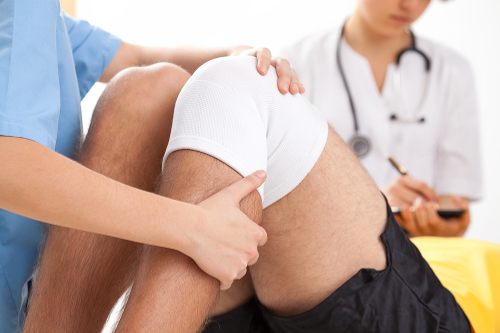 10th Apr 2017
10th Apr 2017
Improving Recovery Outcomes After Knee Joint Replacement Surgery
Severely damaged knees, either from conditions like arthritis or athletic injury, can make it difficult for people to perform daily tasks including: walking, climbing stairs and running without pain. This pain can make what is seen as a simple activity, sitting up or even lying down, a painful task that may require help. The answer for these patients is either a total knee replacement (total knee arthroplasty) or partial knee replacement.

Most often these procedures are last resorts, when medications, walking supports and non-surgical pain relieving treatments have not been effective. Patients who are candidates for either partial or full knee replacements are those who:
- Continue to suffer from chronic leg joint pain
- Have experienced a lack of normal function.
A joint replacement surgery can be an effective treatment for the proper candidates and can help return patients to pain-free function. Innovations in knee replacement surgery has made these treatments two of the most successful procedures in all of medicine. There are more than 600,000 knee replacements performed in the US. each year, a number that continues to rise.
WHAT CAUSES CHRONIC KNEE JOINT PAIN?
Though there are many causes of chronic joint pain and disability with the most common being arthritis. There are three types of arthritis that can cause chronic knee pain:
- Osteoarthritis
- Rheumatoid arthritis
- Post-traumatic arthritis

Osteoarthritis is the most common type of arthritis and is caused by age-related wear of the knee cartilage. When there is wear and tear on the cartilage, the bones may rub together which can cause pain, stiffness and edema.
Rheumatoid arthritis is an auto-immune disease that causes chronic inflammation and thickening of the synovial membrane around the knee. This causes cartilage damage and eventually leads to cartilage loss, which is accompanied by pain and swelling.
Post-traumatic arthritis occurs after a serious knee injury, like a bone fracture to the tibia or femur, which can damage the cartilage. Once the cartilage is damaged, it is more prone for further injury, leading to more pain and a decrease in knee function.
Total Knee Joint Replacement Surgery
Knee joint replacement surgery, or knee arthroplasty, is essentially resurfacing of the knee. The connected pieces of the bones within the joint are replaced with synthetic materials to rebuild the knee joint. For total knee replacements, patients will recover in a hospital for a few days and begin physical therapy while in the hospital.
Partial Knee Joint Replacement Surgery
A partial knee replacement, also called a unicompartmental arthroplasty, is an option for patients that have pain in only one area of the knee joint. Partial knee replacement is resurfacing of the damaged part of the knee, while conserving ligaments and unaffected cartilage. Partial knee replacements have the following advantages over total knee replacements:
- Quicker rehabilitation and less down time
- Better range of motion and movement
- Shorter hospital stays
- Less blood loss
- Lower risk of infection, stiffness, and/or blood clots
90% of knee replacement surgical patients have immediate relief after partial or full knee replacement treatment. Up to 90% are able to have their knee replacement joints last up to 10 years. Physical therapy plays an important role in increasing the success rate of knee joint replacement treatments.
REHABILITATION AFTER KNEE REPLACEMENT

A vigorous physical therapy rehabilitation program will be set up by soon after knee joint replacement with treatment beginning soon after the procedure. Recovery time will depend on a number of variables, but usual time to full recovery from a knee replacement can be as little as three months. Some people might take longer to recover, where they could take up to six months to regain full muscle strength and mobility, and feel really comfortable with their leg joint again. It’s important to have a physical therapy regimen that is adapted to the individual and their specific needs and healing capacity.
As part of the rehabilitation process, physical therapists will use diverse physical therapy modalities to address specific issues that arise as a result of a joint replacement treatment including:
- Swelling
- Pain
- Limited range of motion
Here are the top 5 modalities that are beneficial in addressing these issues as part of treatment:
- Cold Compression Therapy: A summary of research published in the Cochrane Database of Systemic Reviews found that cold therapy is beneficial in reducing pain, blood loss and improving range of motion after a knee replacement. Cold compression therapy combines these benefits with the added benefit of edema reduction and facilitation of tissue repair.
- Therapy Bands: Exercise is an essential part of successful recovery after knee replacement surgery. The main muscle groups to begin strengthening after a knee replacement is the quadriceps and hamstring muscles. The best exercise equipment for hamstrings in knee replacement patients is with resistance bands, which can provide strengthening without unnecessary pressure on the joints.
- Underwater Treadmill: An underwater treadmill is a great piece of rehabilitation equipment that helps improve strength, range of motion, cardiovascular endurance. While underwater, a patient only bears 20% of their weight which removes joint stress on the newly treated joint.
- Warm Water Whirlpool Therapy: Physical therapy is an extremely important part of rehabilitation after knee surgery and can begin as soon as 48-hours post-surgery. Warm water whirlpool therapy can begin within one-week after knee replacement surgery and can help lessen pain and increase mobility.
- Upright Exercise Bike: An upright exercise bike can help patients regain the strength and movement of their knee. In addition, using an upright exercise bike can help
- Reduces Swelling
- Prevents blood clots
- Controls pain
- Prevents constipation
- Improves sleep
Whether a patient undergoes a partial or full knee replacement, it’s imperative to have a good rehabilitation regimen in place to ensure the success of the procedure and the longevity of the replacement joint. Utilizing innovative and diverse physical therapy modalities available to clinicians and customizing regimens based on an individual’s specific needs help improve recovery outcomes. With the right treatment and tools, it’s possible to return joint restore patients to daily activities and function without debilitating pain.
Related Article: Using Physical Therapy to Treat Osteoarthritis Patients with Total Knee Replacements





